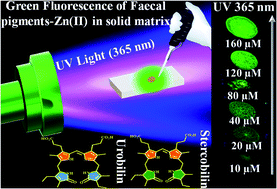Rapid and sensitive naked eye detection of faecal pigments using their enhanced solid-state green fluorescence on a zinc acetate substrate†‡
Abstract
The identification of trace faecal pigments in real-time and on-site detection remains a challenge for water quality monitoring. Herein, a simple, low-cost and rapid fluorescence-based analytical method has been developed in a solid matrix for faecal pigments like stercobilin and urobilin detection. This was made possible due to significant enhancement of green solid-state fluorescence (520 nm) by zinc(II) complexation with faecal pigments embedded in the surface of zinc acetate crystals. It enables naked-eye detection of these pigments even at a 10 μM level when excited with 365 nm blue-UV. It was demonstrated that easily available white cellulose paper strips or TLC silica plates coated with zinc acetate can be used as substrates. A photophysical study of solid-state faecal pigments–zinc(II) complexes suggests that green fluorescence enhancement results from the complexation, which can be attributed to the substantial decrease of the non-radiative decay rate (knr) as well as more efficient use of excitation light. The observation of reduced interference of humic acid fluorescence makes faecal pigment detection more efficient by this proposed method.

- This article is part of the themed collection: #RSCPoster Conference


 Please wait while we load your content...
Please wait while we load your content...